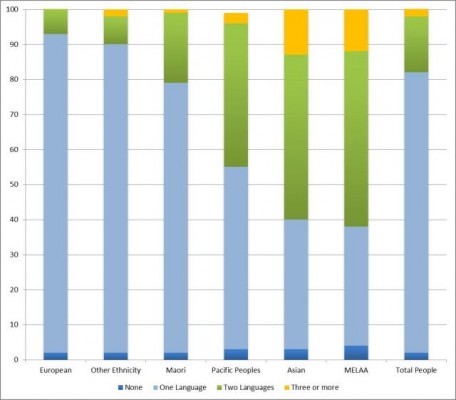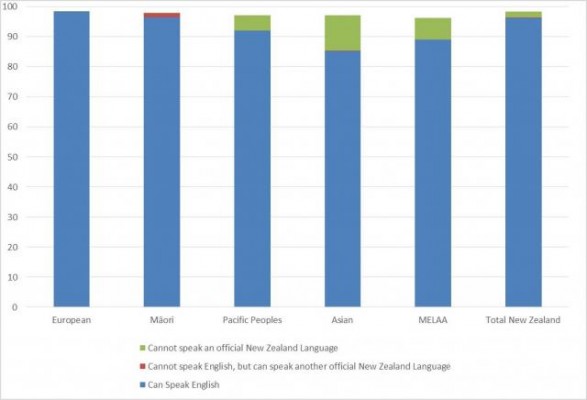Almost everyone speaks English in New Zealand, particularly those born here. But more people in New Zealand also speak other languages. People born overseas are much more likely to speak an additional language.
Figure 1: Number of languages spoken by ethnic group, 2013 (%)

Source: Statistics New Zealand, the New Zealand Census of Population and Dwellings 2013
Figure 1 includes all of the people who stated each ethnic group they belonged to, whether as their only ethnic group or one of several. Where a person reported more than one ethnicity, they have been counted in each applicable group, but only once in the ‘Total People’ group. The source data for this graph have been randomly rounded to protect confidentiality. Percentages may not add up to 100%. Percentages have been rounded to the next full figure. ‘MELAA’ refers to people of Middle-Eastern, Latin American and African descent.
Figure 1 shows the percentage of each ethnic group that can speak one, two or three or more languages. Overall, around 19 per cent of the total population speaks two or more languages. Most people (80 per cent) speak only one language. The European and ‘Other ethnicity’ groups have the lowest percentage of people able to speak more than one language (8 per cent and 10 per cent respectively). The ethnic groups with the highest percentage of people who speak more than one language are Asian (60 per cent) MELAA (62 per cent) and Pacific Peoples (around 44 per cent).
In New Zealand the ability to speak English is very important to the successful settlement and integration of migrants. It can be difficult to maintain the ability to communicate effectively in both English and another language. You can read more about this in the ‘Report on Language and Integration in New Zealand’.
Ethnic group by which languages spoken
Figure 2: Ability to speak an official New Zealand language by ethnic group, 2013 (%)

Source: Statistics New Zealand, the New Zealand Census of Population and Dwellings 2013
Figure 2 includes all of the people who stated each ethnic group they belonged to, whether as their only ethnic group or one of several. Where a person reported more than one ethnicity, they have been counted in each applicable group, but only once in the ‘Total New Zealand’ group. The source data for this graph has been randomly rounded to protect confidentiality. Percentages may not add up to 100 per cent. Percentages have been rounded to the next full figure. Those people with ‘No language’ are not included in this graph. For the sake of clarity, the “Other’ ethnicity group is not included in this graph, but the people in this group contribute to the Total New Zealand group. ‘MELAA’ refers to people of Middle-Eastern, Latin American and African descent.
Figure 2 shows the percentage of each ethnic group able to communicate in an official New Zealand language, or only in a language other than an official New Zealand language.
The Asian, MELAA and Pacific ethnic groups have the highest percentage of people able to speak more than one language (see Figure 1). These are also the communities with the highest percentage of people unable to speak one of New Zealand’s official languages.
Twelve per cent of the Asian population, 7 per cent of the MELAA population and 5 per cent of Pacific Peoples could only communicate in a language ‘other than English, Te Reo Māori and New Zealand Sign Language’. In comparison, only 2 per cent of the total population could not speak an official language of New Zealand.
Proficiency in English allows people to integrate into society. Essentially, if people cannot speak English they will have difficulty connecting with others living here and interacting with most businesses, services and government agencies.
The Office of Ethnic Affairs provides Language Line, a telephone interpreting service to assist people who speak little or no English. Read more about the Language Line telephone interpreting service.
While Language Line can help those with a limited ability to speak English, migrants to New Zealand still need to be proficient in English in order to participate fully in society. See the Language Learning section of this website, to learn more about what languages people are learning, at primary and secondary school, and in tertiary institutions.
Read more about the languages spoken by people born in New Zealand and those born overseas.
Return to Languages spoken in New Zealand
